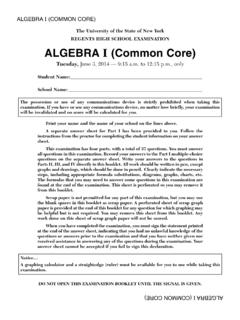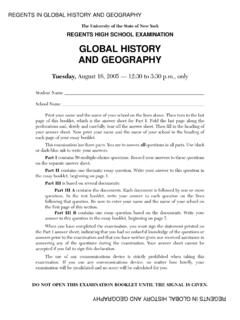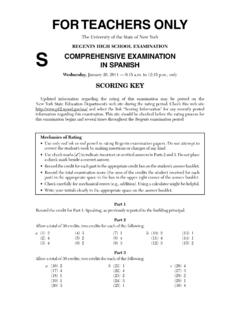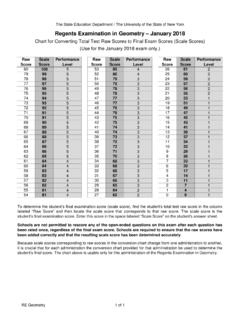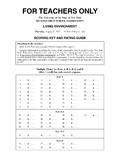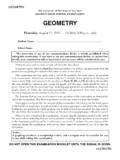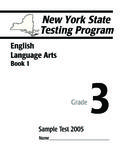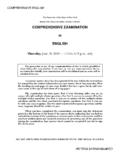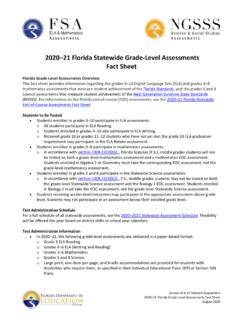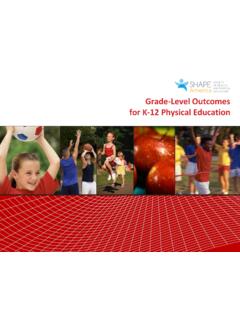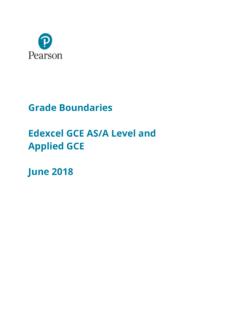Transcription of Grade 8 Intermediate-level Science Test
1 8 THE UNIVERSITY OF THE STATE OF NEW YORK Grade 8 Intermediate-level Science TEST WRITTEN TEST JUNE 4, 2018 Student Name _____ School Name _____ The possession or use of any communications device is strictly prohibited when taking this examination. If you have or use any communications device, no matter how briefl y, your examination will be invalidated and no score will be calculated for you. Print your name and the name of your school on the lines above. The questions on this test measure your knowledge and understanding of Science .
2 The test has two parts. Both parts are contained in this test booklet. Part I consists of 45 multiple-choice questions. Record your answers to these questions on the separate answer sheet. Use only a No. 2 pencil on your answer sheet. Part II consists of 40 open-ended questions. Write your answers to these questions in the spaces provided in this test booklet. You may use a calculator to answer the questions on the test if needed. You will have two hours to answer the questions on this test. DO NOT TURN THIS PAGE UNTIL YOU ARE TOLD TO DO SO.
3 Copyright 2018 THE UNIVERSITY OF THE STATE OF NEW YORK THE STATE EDUCATION DEPARTMENT ALBANY, NEW YORK 12234 Part I DIRECTIONS There are 45 questions on Part I of the test. Each question is followed by three or four choices, numbered 1 through 4. Read each question carefully. Decide which choice is the best answer. On the separate answer sheet, mark your answer in the row of circles for each question by filling in the circle that has the same number as the answer you have chosen. Read the sample question below.
4 Sample Question Earth gets most of its light from (1) the stars (2) the Sun (3) the Moon (4) other planets The correct answer is the Sun, which is choice number 2. On your answer sheet, look at the box showing the row of answer circles for the sample question. Since choice number 2 is the correct answer for the sample question, the circle with the number 2 has been fi lled in. Answer all of the questions in Part I in the same way. Mark only one answer for each question. If you want to change an answer, be sure to erase your first mark completely.
5 Then mark the answer you want. You will not need scrap paper. You may use the pages of this test booklet to work out your answers to the questions. You may use a calculator if needed. When you are told to start working, turn the page and begin with question 1. Work carefully and answer all of the questions in Part I. When you have finished Part I, go right on to Part II. Answer all of the questions in Part II. Grade 8 Science June 18 [3] [OVER] Animal Cell Plant Cell X Part I 1 The diagrams below represent two types of cells, an animal cell and a plant cell.
6 Which type of cell uses energy to carry out life processes? (1) plant cell, only (2) animal cell, only (3) both a plant cell and an animal cell (4) neither a plant cell nor an animal cell 2 A diagram representing the levels of organization within an organism is shown below. (Not drawn to scale) Which level of organization is identifi ed by X? (1) cell (2) tissue (3) organ (4) organ system Grade 8 Science June 18 [4] 3 The diagrams below show models of the circulatory systems of a fish and frog.
7 Heart Fish HeartFrog A student compared these diagrams. The student found that each of these organisms had a heart to pump blood. Which statement is supported by the student s fi ndings? (1) Some organisms are composed of one cell, while others are multicellular. (2) Many multicellular animals have similar organs and specialized systems. (3) The circulatory system in most organisms removes solid wastes from their bodies. (4) All animals have identical circulatory systems. 4 The diagram below represents the life cycle of a butterfl y.
8 Egg Larva Pupa Adult (Not drawn to scale) This life cycle represents the process of (1) separation from parent (2) asexual reproduction (3) metamorphosis (4) extinction Grade 8 Science June 18 [5] [OVER] 5 Water and carbon dioxide are waste products released as a direct result of (1) asexual reproduction (2) mechanical digestion (3) natural selection (4) cellular respiration 6 The primary function of a plant s roots is to (1) absorb water (2) perform photosynthesis (3) produce seeds (4) exchange gases 7 Genes are a part of a (1) cell wall (2) chromosome (3) hormone (4) vitamin 8 Compared to the amount of genetic information contained in a normal human body cell, the amount contained in a normal human sperm cell is (1) the same (2) twice as much (3)
9 One-half as much (4) one-fourth as much 9 The diagram below represents a pedigree chart. Which type of information is organized by this chart? (1) energy fl ow in an ecosystem (2) population growth for pea plants (3) the number of chromosomes in an organism (4) the passing of a trait from one generation to another 10 A change in an animal s DNA, leading to a variation in a species, is called (1) a mutation (2) an infection (3) selective breeding (4) sexual reproduction 11 Which set of terms describes natural fertilization and development in humans before birth?
10 (1) external fertilization, external development (2) external fertilization, internal development (3) internal fertilization, external development (4) internal fertilization, internal development 12 A plant growing toward a light source is an example of an organism (1) attracting a mate (2) destroying infectious germs (3) responding to external stimuli (4) obtaining moisture from the air 13 A cactus plant, a snake, and a hawk can be members of the same (1) community (2) kingdom (3) population (4) species 14 Which substance in green plants needs to absorb sunlight during photosynthesis?

